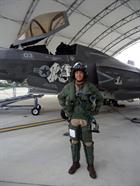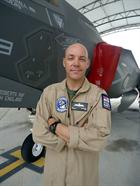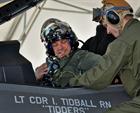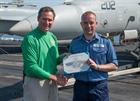Thumbs up from Navy's first pilot of next generation jump jet
Published: 22 May 2013
The Navy’s first pilot of its next-generation jump jet says it will give the nation’s future carriers “unrivalled” striking power.
After a month flying the F35 Lightning II – the most advanced stealth fighter in the world – Lt Cdr Ian Tidball has given the aircraft a glowing testimonial. The veteran Harrier pilot is learning the art of flying the jet, also known as the Joint Strike Fighter, alongside fellow trailblazer Sqn Ldr Frankie Buchler from the RAF, supported by a 13-strong team of British maintainers – seven Royal Navy, six Air Force.
Sqn Leader Buchler was the first full-time British military pilot to take the F35 aloft, followed a few days later by the Ian Tidball – although two Royal Navy reservists, in their ‘day jobs’ as test pilots have flown it: Cdr Simon Hargreaves and Lt Cdr Peter ‘Wizzer’ Wilson.
Speaking at Eglin Air Force Base, Lt Cdr Tidball – who has 1,300 hours behind him in the cockpit of Harriers, followed by time flying the American F18 Super Hornet – says the F35 is “a great aircraft to fly”. He continued: “It’s extremely responsive, it’s got a lot of thrust and the fly-by-wire control system makes the aircraft simple to fly. “My background is the Sea Harrier – a pilot’s aeroplane, a stick and rudder type aircraft. This takes away that sort of demand and frees up the ability of the pilot to operate the mission systems and sensors so that he can deploy the aircraft operationally, effectively.”
The small British team are based with VMFAT 501 – Marine Fighter Attack Training Squadron 501, known as the Warlords, who were formed specially in 2010 to bring the F35 into service with the US Marine Corps. Collectively, the British and American pilots are putting in eight to 12 sorties every day from the air base in north-west Florida – “making progress every day” says Lt Cdr Tidball.
The UK currently has three test versions of the F35B – the short take-off/vertical landing variant of the aircraft – which are being used not just to train the pilots, but also the engineers and technicians in the art of maintaining a stealth fighter which is two generations ahead of the Harrier, the Royal Navy’s last front-line fast jet. Lt Cdr Tidball says the shared experiences of the RN and RAF personnel “complement each other well” and for the first time the two pilots took up the initial two British prototypes for a joint flight. “We are making good progress and a little milestone that really pleased me was that we were up, in formation, together,” said Lt Cdr Tidball. “That really is an indication that this programme is going somewhere. You’ve got British pilots flying British aeroplanes – so great. “It’s a testament to the people that are not just flying it, but are maintaining it as well.”
Although the F35 is assembled in the USA by Lockheed Martin, the fighter is an Anglo-American venture with around one seventh of it designed and built in the UK. Around 130 British firms are providing parts and equipment for it, worth around £1bn per year to the UK economy. And what this Anglo-American joint venture has delivered is an aircraft which is “a massive step up”. Lt Cdr Tidball continues: “It will allow us to deliver a maritime strike capability that’s, frankly, unrivalled, so I’m very excited about the aircraft getting on to the carrier. “The sooner that happens, the better – and I really hope that I’m lucky enough to be there, flying one of these aircraft off it.”
Once training at Eglin is completed – probably next year – the British team is due to decamp from Florida to Edwards Air Force Base in California where, having learned how to fly the F35, they carry out operational tests to prepare it for front-line service. The Fleet Air Arm and Royal Air Force are due to start receiving front-line F35s in 2016, operating out of RAF Marham, near King’s Lynn, where land-based testing and training flights will continue through 2017. The first test flights from HMS Queen Elizabeth are planned in 2018.
USS Dwight D. Eisenhower (CVN-69) (IKE) is one of several U.S. Navy ships training British Sailors on large-deck flight operations as the United Kingdom prepares to launch the new carriers. CPO (AH) Stacy Gager is pictured with Capt. Marcus A. Hitchcock, CO USS Dwight D. Eisenhower





